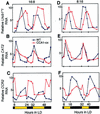Circadian rhythms confer a higher level of fitness to Arabidopsis plants
- PMID: 12068102
- PMCID: PMC161679
- DOI: 10.1104/pp.004374
Circadian rhythms confer a higher level of fitness to Arabidopsis plants
Abstract
Circadian rhythms have been demonstrated in organisms across the taxonomic spectrum. In view of their widespread occurrence, the adaptive significance of these rhythms is of interest. We have previously shown that constitutive expression of the CCA1 (CIRCADIAN CLOCK ASSOCIATED 1) gene in Arabidopsis plants (CCA1-ox) results in loss of circadian rhythmicity. Here, we demonstrate that these CCA1-ox plants retain the ability to respond to diurnal changes in light. Thus, transcript levels of several circadian-regulated genes, as well as CCA1 itself and the closely related LHY, oscillate robustly if CCA1-ox plants are grown under diurnal conditions. However, in contrast with wild-type plants in which transcript levels change in anticipation of the dark/light transitions, the CCA1-ox plants have lost the ability to anticipate this daily change in their environment. We have used CCA1-ox lines to examine the effects of loss of circadian regulation on the fitness of an organism. CCA1-ox plants flowered later, especially under long-day conditions, and were less viable under very short-day conditions than their wild-type counterparts. In addition, we demonstrate that two other circadian rhythm mutants, LHY-ox and elf3, have low-viability phenotypes. Our findings demonstrate the adaptive advantage of circadian rhythms in Arabidopsis.
Figures







References
-
- Ancoli-Israel S. “Sleep is not tangible” or what the Hebrew tradition has to say about sleep. Psychosom Med. 2001;63:778–787. - PubMed
-
- DeCoursey PJ, Krulas JR, Mele G, Holley DC. Circadian performance of suprachiasmatic nuclei (SCN)-lesioned antelope ground squirrels in a desert enclosure. Physiol Behav. 1997;62:1099–1108. - PubMed
-
- DeCoursey PJ, Walker JK, Smith SA. A circadian pacemaker in free-living chipmunks: essential for survival? J Comp Physiol. 2000;186:169–180. - PubMed
-
- Dunlap JC. Molecular bases for circadian clocks. Cell. 1999;96:271–290. - PubMed
Publication types
MeSH terms
Substances
Grants and funding
LinkOut - more resources
Full Text Sources
Other Literature Sources
Molecular Biology Databases

